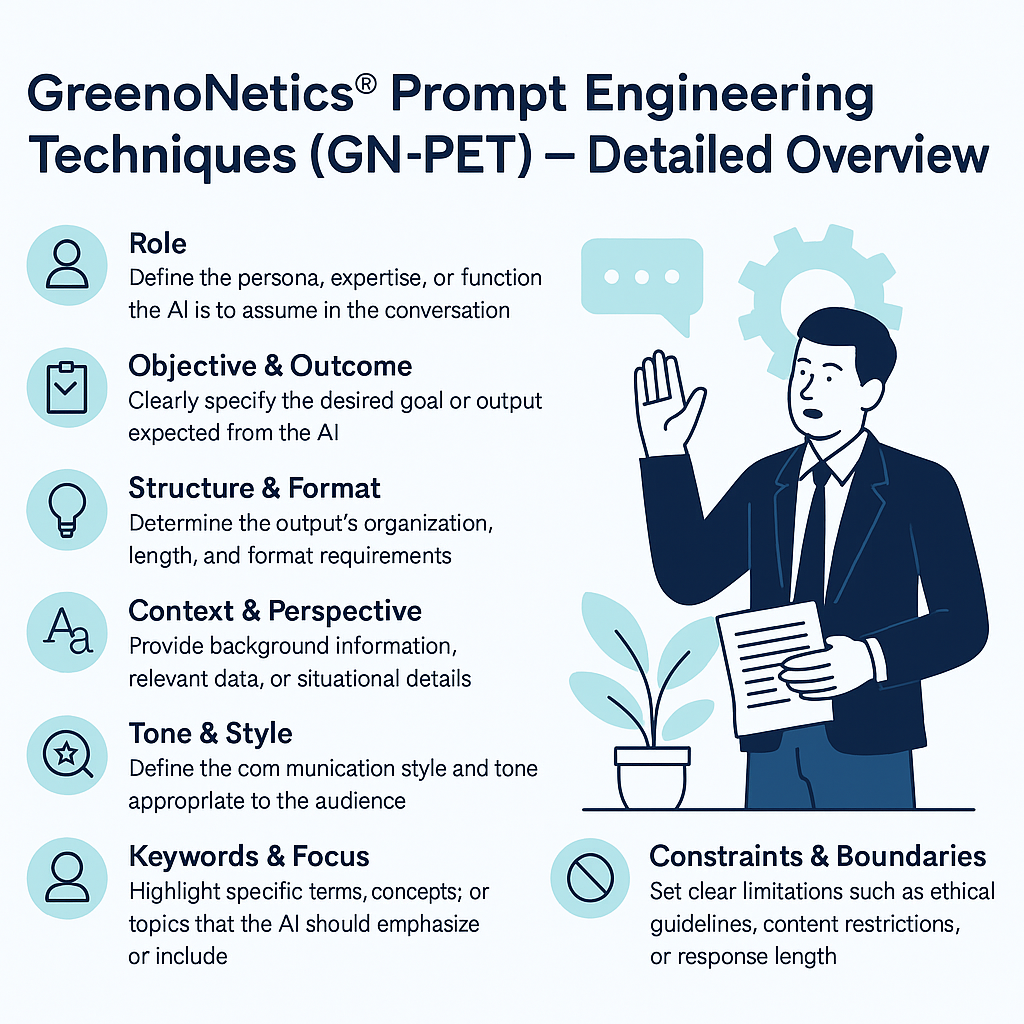The rapid advancement of AI language models presents unprecedented opportunities for organizations to enhance communication, decision-making, and innovation. However, realizing the full potential of these models requires more than simple instruction—it demands strategic, precise, and ethical prompt engineering. GreenoNetics®’ proprietary Prompt Engineering Techniques (GN-PET™) offers a systematic approach to designing prompts that maximize clarity, relevance, and responsible AI output.
GN-PET™ bridges the gap between human strategic intent and AI behavior by rigorously structuring how prompts are crafted, deployed, and iteratively refined, ensuring outcomes align tightly with business and operational objectives.

The GN-PET™ Framework Elements
GN-PET™ is composed of eight key elements that collectively empower prompt designers to create purposeful, contextually rich, and task-optimized prompts:
- GN-PET™ is composed of eight key elements that collectively empower prompt designers to create purposeful, contextually rich, and task-optimized prompts:
- Role: Define the AI’s persona or expertise (e.g., “Act as a financial analyst” or “You are a customer service expert”), setting expectations for response style and content.
- Objective & Outcome: Clearly specify the goal or desired output (e.g., “Generate a marketing plan outline” or “Explain a complex concept in simple terms”).
- Structure & Format: Outline how the output should be organized—whether bullet points, essays, dialogues, or summaries.
- Context & Perspective: Provide essential background, data, or situational details that ground the prompt meaningfully.
- Tone & Style: Tailor the communication style to the audience and purpose (e.g., formal, conversational, persuasive).
- Keywords & Focus: Highlight key terms or concepts for emphasis within the response.
- Audience Level & Knowledge Assumption: Adjust complexity based on the presumed expertise of the audience.
- Constraints & Boundaries: Establish ethical guidelines, content limits, or response length to ensure appropriateness and compliance.
Core Philosophy
At its heart, GN-PET™ conceptualizes prompt engineering as a multidimensional communication exercise—far beyond issuing commands. Prompts are complex messages embedding context, constraints, and clear intent that profoundly shape AI responses. This strategic alignment ensures that AI acts as an effective partner, not just a tool.
Implementation and Application
Iterative Prompt Design: GN-PET™ promotes cyclical refinement—generating outputs, evaluating them, and adjusting prompts—to progressively improve precision and relevance.
Ethical Considerations: The framework incorporates safeguards to mitigate risks such as bias, misinformation, or inappropriate content, supporting responsible AI use.
Cross-Domain Flexibility: GN-PET™’s adaptable structure suits diverse sectors including business strategy, customer service, content creation, education, and defense.
Training and Certification: GN-PET™ underpins the GreenoNetics® Certified Prompt Engineer (GN-CPE®) programs, guiding learners from fundamental White Belt skills to advanced Master Black Belt Trainer expertise in prompt engineering and AI leadership.
Benefits of GN-PET
- Improved AI Output Quality: By providing structured and detailed prompts, GN-PET™ consistently produces clearer, more relevant, and actionable AI responses aligned with strategic goals.
- Enhanced Strategic Alignment: Linking prompts directly to business objectives empowers AI to support decision-making and execution effectively.
- Ethical and Responsible AI Use: Embedding constraints and oversight reduces deployment risks and ensures compliance with ethical norms.
- Scalable Expertise Development: Certification pathways and standardized techniques cultivate mastery and foster organizational AI literacy.
Example: GN-PET™ Prompt Structure in Action
- Role: You are a marketing strategist specializing in digital campaigns.
- Objective: Create a 5-point plan to increase social media engagement for a tech startup.
- Structure: Use bullet points, each with a concise explanation.
- Context: The startup targets young professionals aged 25–35 in urban areas.
- Tone: Professional yet approachable.
- Keywords: engagement, social media, content calendar, influencer partnerships.
- Audience: Marketing team with intermediate knowledge.
- Constraints: Avoid jargon and keep explanations under 50 words per point.

